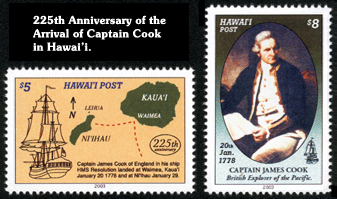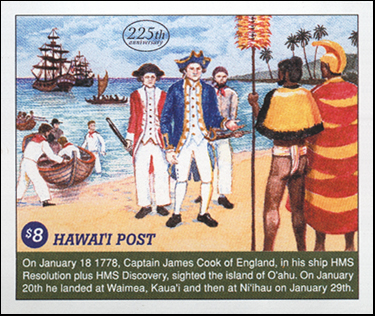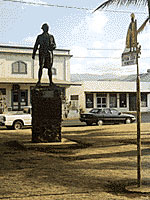.
.
.
.
.
.
.
.
.
.
.
.
.
.
.
.
.
.
.
.
.
.
.
.
.
.
.
.
.
.
.
.
.
.
.
.
.
.
.
.
.
.
.
.
.
.
.
.
.
.
.
.
.
.
.
.
.
.
January 20th 2003 - 225th Anniversary of the Arrival of Captain James Cook in Hawai'i.
Two stamps and a mini-sheet were issued on January 20th 2003 to commemorate the 225th Anniversary of the Arrival of Captain James Cook in Hawai'i.
Two postmarks were issued:
1. January 20 2003. 225th Anniversary of Captain Cook's Arrival at Waimea, Kaua'i, Hawai'i. The postmark shows Captain Cook's sextant which was used to assist him in navigation.
2. January 29 2003. 225th Anniversary of Captain Cook's Arrival at Ni'ihau, Hawai'i. The postmark shows Captain Cook's marine chronometer which was used to assist him in navigation.

The $5 stamp (above left) prepays the Overnight rate. It shows a map of Kaua'i and Ni'ihau with Captain Cook's course and a drawing of Captain Cook's ship, the HMS Resolution.
The $8 stamp (above right) prepays the Same Day rate. It shows a portrait of Captain James Cook by the painter Nathaniel Dance.

The $8 minisheet (above) prepays the Same Day rate. It shows the landing of Captain James Cook at Waimea, Kaua'i on January 20th 1778. The scene was painted by local artist Wayne Takazono who went to great lengths to ensure accuracy of his work.
James Cook was born in Marton in the county of Yorkshire, England on October 27 1728, the son of a farm laborer. He was a grocer's assistant and then became apprenticed to a Whitby shipowner and joined the Royal Navy in 1755 as an Able Seaman on HMS Eagle and soon became Master's Mate. Four years later he was promoted to Master. In 1763 as commander of the schooner Grenville, he surveyed the east coast of Canada over a four year period. The resulting maps were used for many years.
He went on three expeditions to the Pacific Ocean. The first from 1768 to 1771, as Lieutenant on the HMS Endeavour. The second, from 1772 to 1775, as Commander on the HMS Resolution, accompanied by the HMS Adventure. The third and last, from 1776 until his death in 1779 as Captain on the HMS Resolution accompanied by HMS Discovery.
On his last voyage, Captain Cook departed Plymouth, Devon, England on July 12 1776. He circumnavigated and charted New Zealand and also surveyed and claimed for the British Crown, the east coast of Australia. Exploring the rest of the Pacific Ocean, he went to Antarctica, Tahiti, New Caledonia, Christmas Island, Hawai'i and Alaska.
O'ahu was the first Hawaiian island sighted by Captain Cook on January 18 1778, but because of the prevailing northeasterly trade winds, his first landfall was at Waimea, Kaua'i on January 20 1778 and later at Ni'ihau on January 29 1778. At Waimea,"We no sooner landed, that a trade was set on foot for hogs and potatoes, which the people gave us in exchange for nails and pieces of iron formed into some thing like chisels. We met with no obstruction in watering on the contrary the Natives assisted our people to roll the Casks to and from the pond."
 |
.. | Captain Cook's Monument, Hofgaard Park, Waimea, Kaua'i. Photo by Fred Patricio Jr. |
Captain Cook left the Hawaiian Islands On February 2nd. "These five Islands, Atoui, Ene-e-he-e-o-u-, Orrehoua, Otaoora and Wouahoo, names by which they are known to the Natives, I named Sandwich Islands, in honour of the Earl of Sandwich".
Captain Cook then sailed up to Alaska to seek the elusive "Northwest Passage" from the Pacific Ocean to the Atlantic Ocean. Unsuccessful, he returned to Hawai'i and on February 14th 1779, after he re-landed on the Big Island to recover a stolen row boat, he was clubbed to death by some Hawaiians. His body was never recovered.
Notice that we do not mention (on the stamps or in the text above) that Captain Cook "discovered" Hawai'i. That's because he didn't. The first human discovery of Hawai'i was believed to be in the 8th century by Marquesans from what is now French Polynesia, who came north in their canoes around that time. However, you could say that Captain Cook was the first European to "discover" Hawai'i.
WE ACCEPT CREDIT CARDS ON ALL ORDERS
![]()
![]()
![]()
![]()
Technical details of the stamps and mini-sheet:
Colors: $5, $8 stamps and $8 mini-sheet - Multicolored
Size: 32mm x 48mm (stamps). 84mm x 70mm (mini-sheet)
Stamps sheet size: $5 - 30 (6 down, 5 across), $8- 30 (5 down, 6 across),
Perforation: 12. Mini-sheet - imperforate.
Stamps design: Enelani.
Mini-sheet design: Wayne Takazono.
Layout & Pre-press: Enelani.
Printer: Hawai'i Security Printers, Honolulu, Hawai'i.
Printing Method: 4-color (Cyan, Magenta, Yellow and Black) printing process.
Sheet margin markings: HAWAI'I POST (top middle), "Traffic Light" showing 4 colors used in printing (lower left side), © 2003 Hawai'i Post (lower right side) & Hawai'i Security Printers, Honolulu, Hawai'i. (bottom middle)
Paper: GPA coated white stock with water-activated gum on the back.
Return to list of stamp issues
For details on upcoming stamp issues click here